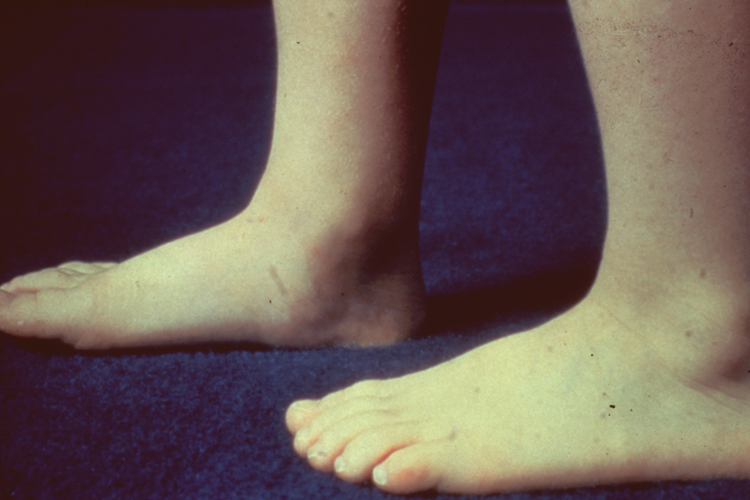

SUMMARY
-
Flexible Pes Planovalgus, also known as Flexible Flatfoot, is a common idiopathic condition, caused by ligamentous laxity that presents with a decrease in the medial longitudinal arch, a valgus hindfoot and forefoot abduction with weight-bearing.
-
Diagnosis can be made clinically with a foot that is flat with standing and reconstitutes with toe walking, hallux dorsiflexion, or foot hanging.
-
Treatment is usually observation, and stretching with majority of cases resolving over time. Rarely, surgical management is indicated for patients with progressive deformities that do not resolve with nonoperative management.
EPIDEMIOLOGY
ncidence
-
unknown in pediatric population
-
20% to 25% in adults
ETIOLOGY
-
Pathoanatomy
-
generalized ligamentous laxity is common
-
25% are associated with gastrocnemius-soleus contracture
-
CLASSIFICATION
-
Hypermobile flexible pes planovalgus (most common)
-
familial
-
associated with generalized ligamentous laxity and lower extremity rotational problem
-
usually bilateral
-
-
associated with an accessory navicular
-
correlation is controversial
-
-
-
Flexible pes planovalgus with a tight heel cord
-
Rigid flatfoot & tarsal coalition (least common)
-
no correction of hindfoot valgus with toe standing due limited subtalar motion
-
PRESENTATION
-
Symptoms
-
usually asymptomatic in children
-
may have arch pain or pretibial pain
-
-
Physical exam
-
inspection
-
foot is only flat with standing and reconstitutes with toe walking, hallux dorsiflexion, or foot hanging
-
valgus hindfoot deformity
-
forefoot abduction
-
-
motion
-
normal and painless subtalar motion
-
hindfoot valgus corrects to a varus position with toe standing
-
evaluate for decreased dorsiflexion and tight heel cord
-
-
IMAGING
-
Radiographs
-
indications
-
painful flexible flatfoot to rule out other mimicking conditions
-
rigid flatfoot
-
-
recommended views
-
required
-
weightbearing AP foot
-
evaluate for talar head coverage and talocalcaneal angle
-
-
weightbearing lateral foot
-
evaluate Meary's angle
-
-
weightbearing oblique foot
-
rule out tarsal coalition
-
-
-
optional
-
plantar-flexed lateral of foot
-
rules out vertical talus (where a line through the long axis of the talus passes below the first metatarsal axis)
-
-
AP and lateral of the ankle
-
if concerned that hindfoot valgus may actually be ankle valgus (associated with myelodysplasia)
-
-
-
-
findings
-
Meary's angle will be apex plantar
-
angle subtended from a line drawn through axis of the talus and axis of 1st ray
-
-
-
DIFFERENTIAL
-
Tarsal coalition
-
Congenital vertical talus
-
Accessory navicular
TREATMENT
- Nonoperative
-
observation, stretching, shoewear modification, orthotics
-
indications
-
asymptomatic patients, as it almost always resolves spontaneously
-
counsel parents that arch will redevelop with age
-
-
-
techniques
-
athletic heels with soft arch support or stiff soles may be helpful for symptoms
- orthotics do not change natural history of disease
-
UCBL heel cups may be indicated for symptomatic relief of advanced cases
-
rigid material can lead to poor tolerance
-
-
stretching for symptomatic patients with a tight heel cord
-
-
-
-
Operative
-
Achilles tendon or gastrocnemius fascia lengthening
-
indications
-
flexible flatfoot with a tight heelcord with painful symptoms refractory to stretching
-
-
-
calcaneal lengthening osteotomy (with or without cuneiform osteotomy)
-
indications
-
continued refractory pain despite use of extensive conservative management
-
rarely indicated
-
-
technique
- calcaneal lengthening osteotomy (Evans)
-
with or without a cuneiform osteotomy and peroneal tendon lengthening
-
-
sliding calcaneal osteotomy
-
corrects the hindfoot valgus
-
-
plantar base closing wedge osteotomy of the first cuneiform
-
corrects the supination deformity
-
- calcaneal lengthening osteotomy (Evans)
-
-
PROGNOSIS
-
Most of the time resolves spontaneously

